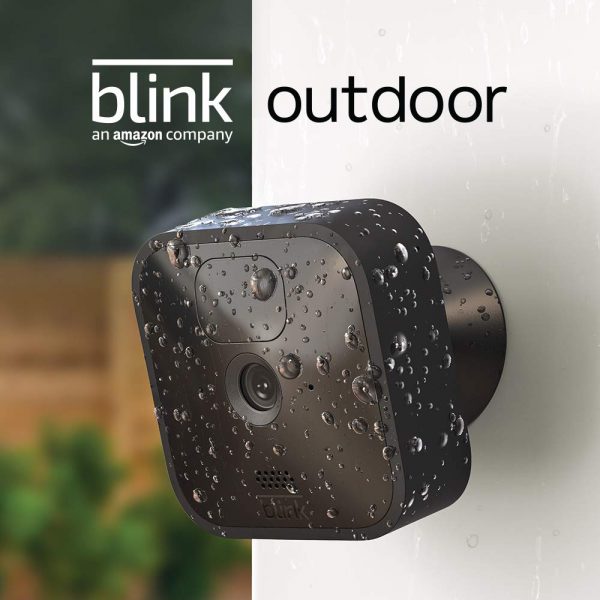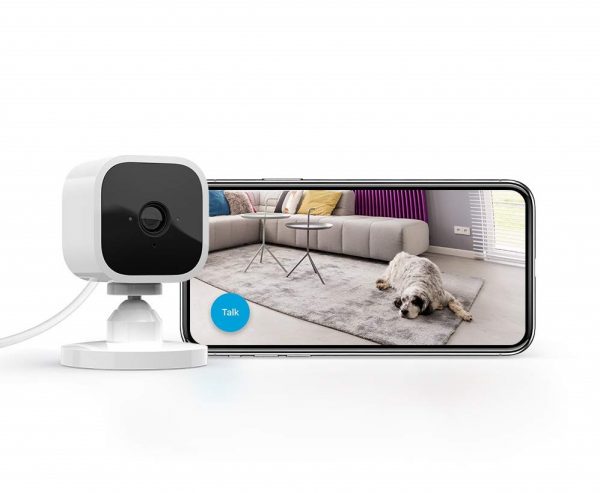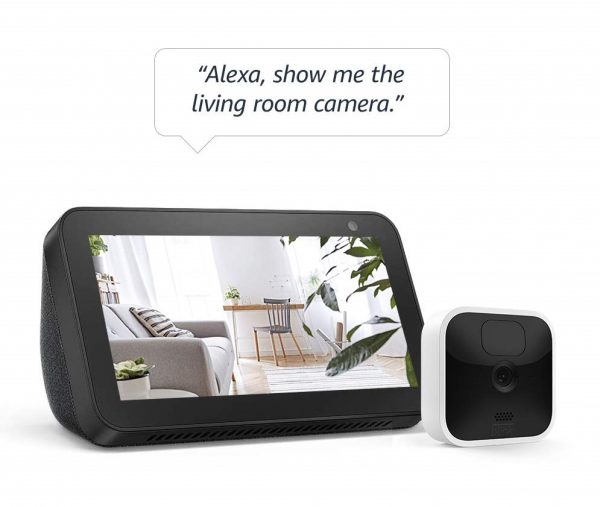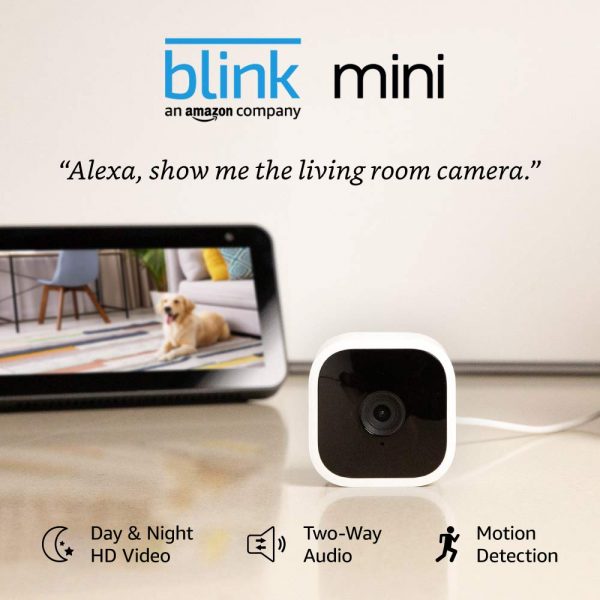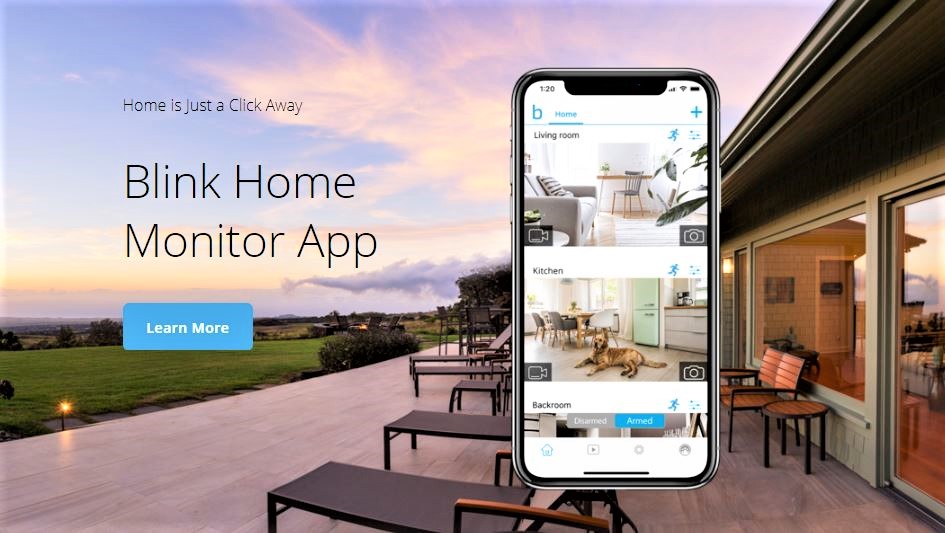Blink Camera: Overview
All these factors already make the camera lineup pretty good. However, the most impressive feature is probably the battery life. With just two AA batteries, you can power up the Blink Outdoor or Blink Indoor for two years. The best part? Blink camera products don’t cost a fortune. They all retail for less than $100, making them some of the most affordable home security cameras for sale.
Blink Camera: Features
As you know, there’s more than one camera in the product lineup. This is because each one has a different set of features made for different areas of the home. There’s one for indoor use, another for outdoor use, and the cheapest one is a tabletop device. Here’s everything you need to know about each camera in the lineup.
Blink Outdoor
When you’re setting up a security system, you most probably want to cover all your bases. That means getting security cameras for both indoor and outdoor use. As you may have guessed, the Blink Outdoor device covers the latter.
Weather-Proofing
The most obvious obstacle that might keep people from getting an outdoor security camera is the weather. Weather conditions can be turbulent and there’s no guarantee that you can keep regular cameras safe. That’s where the Blink Outdoor camera shines: it is mostly weatherproof. It has an IP65 water resistance rating, meaning that it can withstand rain, dust, and snow. You can safely leave it outside even without a roof over its head. Of course, like all technology, this camera has a weather limit. For one, its operating temperature caps at 113 °F with a minimum of negative 4 °F. Hence, you might need something else if you need something for extreme climates. If you’re not sure about your front yard’s temperature levels, the camera is equipped with a temperature gauge. This allows it to measure whether the surrounding temperature is too high or too low. In this case, it will drop you a notification to bring it indoors.
Video & Recording Quality
What would security cameras be if they can’t record videos well? Fortunately, the Blink camera system generally provides decent video and audio quality. To start, the cameras boast a 110° field of view with adjustable motion zones—you can be sure that they will capture most of the surrounding area in each sitting. Moreover, the cameras record in 1080p, ensuring that you have a good picture quality to see objects and distinguish faces. This even allows you to see minute details on shirts, license plates, and more. In terms of audio, the outdoor Blink camera comes fully-equipped with two-way audio. Hence, you can see who’s at the door and talk to them before letting them in. This provides a layer of security, especially when strangers show up at your door. The audio quality itself is pretty decent too, although it can be hard to listen through it when there’s outside noise. There’s no onboard noise reduction feature either, so it might not do well on windy or rainy days. In addition, the outdoor Blink camera is equipped with night vision. However, it’s a little lackluster compared to the camera’s daytime performance. You can barely tell people’s faces apart in this mode, so it doesn’t have amazing quality. Additionally, far-off objects can appear blurry on camera.
Others
There are also tons of other smaller features the Blink camera has. They don’t fall under one umbrella category, but they are worth mentioning. Firstly, the outdoor Blink camera is powered by two AA batteries that can last up to two years. It also comes with cloud and local storage, although the cloud storage isn’t free. While you can opt for local storage, you’ll need an additional device. Apart from these, the outdoor Blink camera is also wireless. This adds to its weatherproofing as none of its parts will be prone to the elements. Furthermore, it makes the Blink camera easier to set up with no clunky wires to connect around the house.
Blink Indoor
The indoor Blink camera shares many of the same features as the outdoor one. However, it’s more stripped down because it doesn’t include any weatherproofing. Of course, that also means it has a narrower temperature threshold. Generally, you can place it anywhere indoors with temperatures between 32 and 95 °F. That might sound inconvenient, but it’s also the reason why it’s cheaper. With the indoor Blink camera, you get the same wireless design in a compact package. This lets you mount it just about anywhere as long as it has a flat surface. You can mount it on a wall, install it on your ceiling, or even put it on a shelf. Like the outdoor Blink camera, this one also runs on AA batteries with a two-year lifespan.
Blink Mini
The Blink Mini is probably the most distinct out of the three Blink cameras. That’s because it’s a standing camera instead of something you can mount on a surface. Think of it as a webcam for home security. Unfortunately, the Blink Mini doesn’t come with the bells and whistles of the other two. That’s because it has a wired connection, requiring a power source instead of batteries. Hence, you can’t just decide to place it on any flat surface around the house. You have to think of how to manage the cords before you position this Blink camera anywhere. This may seem inconvenient, but it does have a positive side to it: you don’t have to worry about running out of batteries and changing them. Unfortunately, it does render the camera useless during a power outage. Apart from these, you’ll notice that the Blink Mini is smaller than the other two—perfect for helping it to stay out of sight if intruders enter your home. You might think that the features that the Blink Mini lacks make it inferior to the outdoor and indoor Blink cameras. However, keep in mind that it’s significantly cheaper than the others. Moreover, it keeps the same core functions and features that the other Blink cameras have.
Blink Sync Module 2
We have so far covered three products in the Blink camera lineup. There’s also a fourth one, but it’s optional to the whole setup. This is the Blink Sync Module 2. The Blink Sync Module 2 is Blink’s local storage solution for your Blink camera. As you know, the Blink camera products can connect to a centralized cloud. However, they require a subscription to a storage service that not everyone likes. The alternative is to store files locally which you can do through this device. How does it store footage? The Blink Sync Module 2 works by allowing you to store files in a USB flash drive. You can then transfer the files to your computer for later viewing. Do note that this little device can only support up to ten Blink camera devices. Also, the Blink Sync Module 2 is only compatible with the aforementioned Blink camera devices. Hence, you can’t use it with other Blink products like the Blink XT or XT2. If you’re okay with that, you can buy it separately or through Blink’s camera kit bundle.
Blink Camera: Installation
The Blink camera family of products is pretty easy to install. All you need is to download the app, make an account, and follow the setup instructions. It guides you through what to do, telling you which QR codes to scan and what to set up. If you buy a Blink Sync Module 2, it’ll likely set that and the entire system up first. Afterward, setting up the Blink camera follows more or less the same path. You scan QR codes, add them to the system, and connect them to the network. The physical installation of the Blink camera module itself shouldn’t be too much trouble either. This is because each one has a mounting base you can use to attach the camera almost anywhere. Just mount the base first and then snap the camera into place. You do something similar with the Blink Mini, but that one doesn’t mount permanently onto a surface.
Blink Camera: Internet Requirements
One thing that is a must-have for Blink camera owners is a capable internet connection. Like most security cameras, the Blink camera products take up quite a bit of bandwidth. You will thus need a good, stable internet connection to even view each camera’s live stream. There are many ways to tell whether your internet connection is too slow for your Blink camera. Firstly, when you have trouble accessing videos, creating thumbnails, or motion clips, that’s one tell-tale sign. Another is when you get a “time out” alert from the Blink app when attempting to view the footage. Lastly, if the connection says “Unable to communicate with the camera,” you’ll know there’s a problem. If you find yourself running into all these alerts, then it’s time for an upgrade. As a rule, the Blink camera system requires high-speed network connections. This means it needs at least 2 Mbps in upload speeds. Of course, these connection problems might also occur whenever the network is crowded. Distance from the Wi-Fi router and obstacles in the way can also create problems. It’s thus important to blanket your home with a solid internet connection if you want to buy a Blink camera. These network requirements don’t necessarily make the Blink camera system bad. However, they are something to keep in mind before you opt to purchase one. If you’re not ready to properly set up your network for a Blink camera, then it’s better to skip the purchase altogether.
Blink Camera: Price
*Camera kits include a Blink camera and an accompanying Blink Sync Module 2 If you’re not one to store local footage, Blink also offers cloud storage solutions. However, you can’t link it to storage subscriptions you already have from sites like DropBox. You need to subscribe to a separate Blink service. The subscription plans are as follows:
Summary & Conclusion
The Blink camera line of products is great for home security. They’re powerful, versatile, and easily affordable for middle-class families. However, they come with a couple of requirements that not everyone is ready for.

